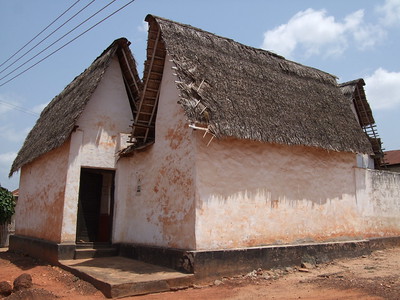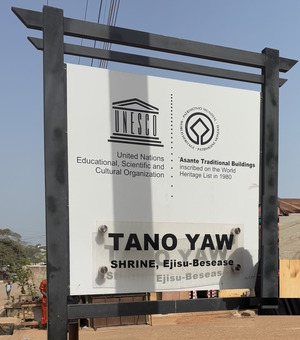Asante Traditional Buildings

The Asante Traditional Buildings are the only surviving examples of traditional Asante architecture.
They are shrines/fetish houses decorated with symbolic bas-reliefs. The buildings traditionally have steep thatched roofs on top of a timber framework filled up with clay. Each building consists of four rooms around a quadrangular courtyard. Some of the enlisted buildings still have priests, some don't.
Community Perspective: it has taken a lot of research to find out which buildings are part of this WHS as it lacks an official map; the opinion at the moment is that there are 10 of them, but not all coordinates and names are known. Els and Solivagant both visited Besease shrine, the easiest to reach from Kumasi. Jarek additionally covered Aduko Jachie and Kentikrono in his review.
Map of Asante Traditional Buildings
Community Reviews
Little Lauren Travels
I booked a tour with a local company, Ashanti African Tours, to spend four days in Ghana, visiting the forts and the Asante traditional buildings as well as the Akwasidae Festival, a traditional Asante festival that happens once every six weeks. I was too focused on visas and anti-malarials and a snow storm to closely check the itinerary, which just had an afternoon visiting the site. I was disappointed to learn that only the shrine at Ejisu-Besease had been included. I asked that more be added and also visited Adako-Jackie, which is nearby. I would be specific on any tour and say you want to visit multiple of the shrines. Although I usually have a 30% rule — e.g., have to see at least 30% of the components of a site — I am going to mark this one off, as I did the best I could and I already compromised my rule with the Stecci.
As to the buildings, they are shrines built in the traditional Asante style, often in the 1800s to early 1900s. Due to the wars with the British, there are only around ten such buildings remaining. In many cases, there have been shrines on the sites for hundreds of years. This he shrines typically have four buildings around an open courtyard and have decorated walls and thatched roofs. Some of the thatched roofs are being replaced by metal ones to better protect the buildings and lower maintenance costs. The shrine at Adako-Jachie was under active renovation when I visited and was larger and had more decorations (but no thatched roof).
Date of Visit: January 2025
Rating: Three stars. I am torn on how to rate sites like these, and I went with a three because it’s nice to have a diversity of non-European cultural sites on the list, even if they aren’t as dramatic as Angor Wat or the pyramids of Giza. The sites were actually relatively well labeled with descriptions about how the buildings were used, and it appears that the government is restoring the buildings. It would be great to have a website that clearly marks all locations.
Logistics: See above. Booked a multi-day tour. The buildings are generally locked, and a local keeps the key and will let you in for a tip. It can be done on self-drive or by taxi from Kumasi, but would take some work to hunt down the keys. A local tour, including a day trip from Kumasi, would be helpful.
Signs: Both sites had new signs indicating the name of the site and UNESCO status as part of the Asante traditional buildings. The signs were in the same style as the signs marking the forts and castles sites.
Jarek Pokrzywnicki

Visited March 2014, the easiest shrine to get is Ejisu Besease - in fact located in Besease village (there is public transport from Kumasi), the only shrine that is well known (to locals) as well as promoted (Ghanaian Tourist Board - Kumasi Branch), other places are more difficult to be visited.
While in Besease it is possible to visit 3 other shrines that are located quite close. Aduko Jachie is located just north of main Kumasi - Accra road (Bradt guide shows exact location), there are no plates nor any other marks of the village. The shrine is located in the northern part of the village (unnoficial entrance fee is 15 Cedi quite a lot comparing to 4 Cedi in Besease). The whole building looks quite usual from the outside (just like surrounding other houses), courtyards preserves some Asante ornaments - most of them in poor condition. In official whc.unesco.org webiste it was mistakingly named Adarko Jachie.
More close to Kumasi lies Kentikrono, some 5-6 km from Aduko Jachie, also just nort of the main Kumasi - Accra road. The shrine lies in eastern part of village - ask for Asante shrine or Ghana Museum as the locals call it. Some ornaments are placed outside the building (photo above), more are in the courtyard. Unfortunately whan I was there the building was locked (as locals say the guy responsible for the shrine works in Kumasi). In official whc.unesco.org webiste it was mistakingly named Kentinkrono.
Another shrine is located some 5 km south of Ejisu, Atia Kusia Kwame shrine in the village of Edwenase. I haven't been there personally but the site is well known in the area (photos are available also inside Besease shrine).
Jorge Daniel Magaña García
I visited the shrine at Besease, which bears testimony to the once impressive Ashanti Kingdom, as you can see on the photos showcased there. I think the stories its walls tell are what gives this site its meaning and authenticity mark, as the site itself might be overlooked by some tourists. It's unfortunate though that UNESCO has not given attention to other sites around the area which I believe, even if they have post-colonial influences, could also be considered the last remains of a culture that is slowly degrading. I went to Aburi to take a look at lake Bosomtwi, and it was then when I really felt the declaration should encompass a wider range of cultural assets. Further efforts should be made to protect the small towns around Kumasi too. In conclusion, I think focusing on the shrines as living proof of Ashanti's people traditions and values is a little reductive to be honest, and real measures to enlarge the declaration or nominate more sites should be taken.
Solivagant

We visited the Ashanti Shrine at Besease in Nov 2010. Our research (the Nomination File, the Web and the Bradt Guide) indicated that it was the easiest and best of the 10 (or 13?) shrines to visit from Kumasi and I have no reason to doubt this judgement. We traveled by coach from Accra to Kumasi and, as we were very short of time, arranged to be dropped off at the village of Ejisu on the main road about 20kms short of Kumasi. The shrine is signed from the main road road and is set back around 200 yards to the left facing Kumasi.
The old man who is "guardian" (the same guy as in Els's review and photo) and can open up isn't there all the time and will probably have to be fetched from the village somewhere but locals in shops/stalls nearby the shrine seem to know where to get him. We were warned that he might be "some (African??) time" but in our case they found him in around 10 minutes. He expects a tip on top of the entrance of course so he has good reason to come!
An hour is enough to see the shrine and have the old man "doing" his grass skirt show (said skirt is hanging ready on one of the walls!). As Els says, the old guy doesn't speak English but a local school-boy teamed up with us to explain the libation ceremonies etc which were not really covered by the English wall signs. These take place in front of the sacred tree (photo). It might have been nice to have had a taxi for a day and to have visited a few more of the shrines there are others on the Ejisu side of Kumasi – but more to “experience” Ghana’s village life and interact with the locals than because Besease lacked anything which such shrines have to offer.
The shrine’s fabric looked in reasonable condition – the roof possibly needed rethatching but, no doubt, this is normal every few years for such structures. But as a “tourist attraction” it was very low key (not that this should necessarily be regarded as a negative!!). A couple of signs advertising its UNESCO status lay rusting on the ground alongside the building.
Kumasi is a large city (pop c 1.5 million) and its traffic is chaotic. Having reached the centre and your hotel you might be tempted to stay there for its sights (Market, palace and museum etc). The Besease shrine is pretty low key but having reached Kumasi it is worth going back out to take it in I feel.
Els Slots

During my stay in Kumasi, I hired a driver for the day and we went on a tour across the surrounding countryside. There are a couple of interesting craft villages to visit. There you can see Kente-weaving (in Adanwomase) or the dyeing of Adinkra-cloth (in Ntonso). To satisfy one of my WHS goals of this trip, we also included the Besease shrine. It is located near Ejisu, 20 km east of Kumasi.
The building is whitewashed on the outside and includes a very steep thatched roof. It originally dates from ca. 1850, but it was fully restored in 1998. There’s a 2 cedi’s entrance fee, collected by a caretaker who didn’t seem to speak English but clearly loves guests and being photographed. After the restoration, the building was turned into some kind of museum. There are photographic displays on its walls of other traditional buildings, and good explanations in English.
The whole compound is quite small, so it is kind of an underwhelming experience. You’ll have to try hard to spend more than 10 minutes inside. Don’t overlook the fetishes that lie around in the courtyard: there’s a tortoise for example, and strings of sheep and goats’ vertebrae (from sacrificed animals). Women who can’t get pregnant are said to still visit the shrine. The shrines obviously are part of a living tradition that now almost has gone. However, they have been included in the World Heritage List for their vernacular architecture. A wonderful feature is the symbols carved into the clay of the interior walls.
Community Rating
Site Info
- Full Name
- Asante Traditional Buildings
- Unesco ID
- 35
- Country
- Ghana
- Inscribed
- 1980
- Type
- Cultural
- Criteria
-
5
- Categories
- Archaeological site - Civilizations of Sub-Saharan Africa
- Link
- By ID
Site History
1980 Inscribed
1979 Deferred
Bureau - More info wanted
Site Links
Unesco Website
Official Website
Related
From the Forum
Locations
The site has 13 locations
Connections
The site has 12 connections
Art and Architecture
Ecology
History
Religion and Belief
Timeline
Trivia
Visiting conditions
WHS on Other Lists
World Heritage Process
Visitors
45 Community Members have visited.
